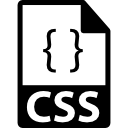CSS: Difference between revisions
Mr. MacKenty (talk | contribs) |
Mr. MacKenty (talk | contribs) |
||
| Line 36: | Line 36: | ||
Please [https://www.w3schools.com/cssref/ click here for a well organized list of properties] | Please [https://www.w3schools.com/cssref/ click here for a well organized list of properties] | ||
== Units of measurements == | |||
== Standards == | == Standards == | ||
Revision as of 15:38, 31 August 2017

Cascading Style Sheets (CSS) is a style sheet language used for describing the presentation of a document written in a markup language. Although most often used to set the visual style of web pages and user interfaces written in HTML and XHTML, the language can be applied to any XML document, including plain XML, SVG and XUL, and is applicable to rendering in speech, or on other media. Along with HTML and JavaScript, CSS is a cornerstone technology used by most websites to create visually engaging webpages, user interfaces for web applications, and user interfaces for many mobile applications.[2]
Although this is debatable, CSS is a Domain-specific declarative language. It serves a very specific purpose in a rather narrow capacity when compared to other formal programming languages.
Basic ideas[edit]
CSS Syntax[edit]
At its most basic level, CSS consists of two building blocks:
- Properties: Human-readable identifiers that indicate which stylistic features (e.g. font, width, background color) you want to change.
- Values: Each specified property is given a value, which indicates how you want to change those stylistic features (e.g. what you want to change the font, width or background color to.)
A property paired with a value is called a CSS declaration. CSS declarations are put within CSS Declaration Blocks. And finally, CSS declaration blocks are paired with selectors to produce CSS Rulesets (or CSS Rules).[3]
Selectors[edit]
- Selectors define to which elements a set of CSS rules apply. [4]
Properties and Values[edit]
Moziulla developers network has excellent resources and information for CSS[5]
- Properties: Human-readable identifiers that indicate which stylistic features (e.g. font, width, background color) you want to change.
- Values: Each specified property is given a value, which indicates how you want to change those stylistic features (e.g. what you want to change the font, width or background color to.)
Please click here for a well organized list of properties
Units of measurements[edit]
Standards[edit]
- Define CSS
- Discuss structure of CSS and the cascade
- Demonstrate knowledge and skill using selectors
- Demonstrate knowledge and skill using values and units
- Demonstrate knowledge and skill using text properties
- Demonstrate knowledge and skill using basic visual properties
- Demonstrate knowledge and skill using padding, borders and margins
- Demonstrate knowledge and skill using colors, borders and backgrounds
- Demonstrate knowledge and skill using floating and positioning
- Demonstrate knowledge and skill using box model
References[edit]
- ↑ http://www.flaticon.com/
- ↑ https://en.wikipedia.org/wiki/Cascading_Style_Sheets
- ↑ https://developer.mozilla.org/en-US/docs/Learn/CSS/Introduction_to_CSS/Syntax
- ↑ https://developer.mozilla.org/en-US/docs/Web/CSS/CSS_Selectors
- ↑ https://developer.mozilla.org/en-US/docs/Learn/CSS/Introduction_to_CSS/Syntax
